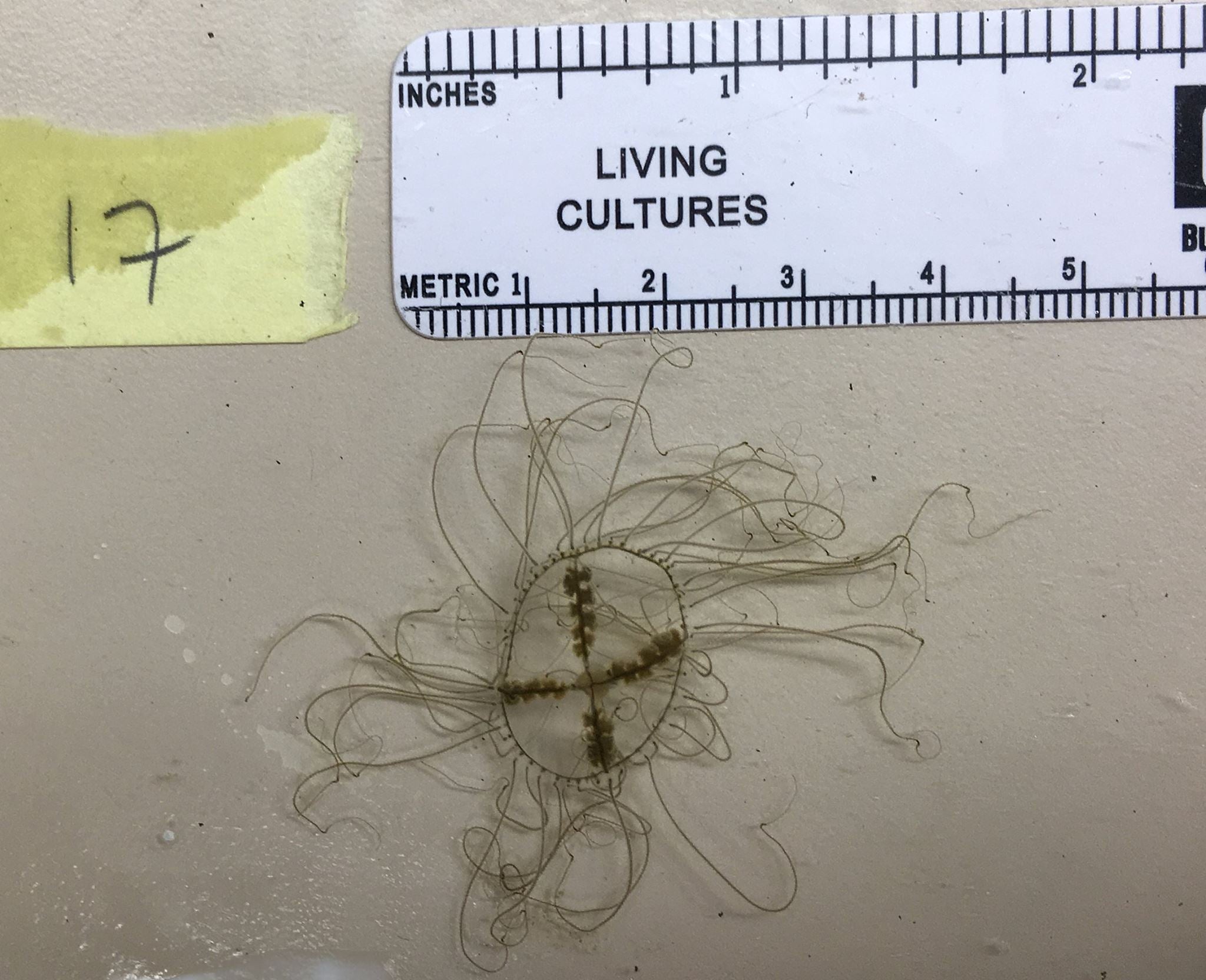6 things to know about clinging jellyfish

A clinging jellyfish.(Image: Dr. Paul Bologna/New Jersey Jellyspotters via Facebook)
Observers in New Jersey waterways once again have found the rare, dime-sized clinging jellyfish that researchers once thought had become extinct along the East Coast.
Clinging jellyfish are described by Oceanus Magazine as resembling “a piece of art glass or a flash bling brooch you would never want to wear” with “hula-hoop skirts of 60 to 90 glass-like tentacles that uncoil sharp threads and emit painful neurotoxin.”
17 small adults were spotted last Friday in Monmouth County’s Shrewsbury River, according to New Jersey’s jellyfish expert, Montclair State University Director of Marine Biology Dr. Paul Bologna.
But the expert, who’s tracking sampling and spotting locations here, says they’re not expected on ocean beaches since the jellyfish prefer clinging to vegetation in sheltered bay and estuarine waters.
Bologna is in the second year of a research study in partnership with the New Jersey Department of Environmental Protection. (He regularly posts in the Facebook group New Jersey Jellyspotters.)
The researcher and his team are working to “gain a better understanding of their presence and to what extent they are increasing in these waters,” DEP Commissioner Bob Martin said.
Last summer, in addition to the Shrewsbury River, clinging jellyfish were spotted in the Manasquan River and in the Point Pleasant Canal near the Barnegat Bay in Ocean County.
The New Jersey Department of Environmental Protection has released this fact sheet on clinging jellyfish:
WHAT IS IT?
The clinging jellyfish (Gonionemus vertens) is a small hydrozoan jelly fish about the size of a dime that can be found in bay and estuarine waters.
WHERE ARE THEY FOUND?
Clinging jellyfish are native to the Pacific Ocean. They were introduced to the eastern Atlantic Coast as early as 1894 in Woods Hole, Massachusetts, but can be found from Maine to North Carolina. Clinging jellyfish thrive in temperate regions, and can be found in sheltered shallow bay and estuarine waters where tides are not strong enough to dislodge them. They prefer to cling to vegetation and other substrates (e.g. shells) during the day. They typically feed at night in the water column on small marine animals (zooplankton), but have been observed during the day. They are not typically found in coastal ocean waters.
HOW BIG DO THEY GET?
This is a small jelly fish that only grows to about 25 mm (1 inch) in diameter, but it can expand to about three inches in diameter. They have 60-90 tentacles that contain the nematocysts or stinging cells.
WHY ARE THEY IN NEW JERSEY WATERS?
Although they have not been previously reported in New Jersey waters until last year, their presence here may be a recent introduction, or they may have gone unnoticed in the past. They do not produce large populations as do some other jellyfish, but can be found in local areas in small to moderate numbers.
WHAT CAN WE EXPECT THIS SUMMER?
This jelly fish is considered to be an erratic species, meaning that it is not often densely populated. They are often active during periods of unseasonably warm weather and increased water temperatures. Additionally, clinging jellyfish are not likely to be abundant in areas heavily used by swimmers, but could affect casual waders and people gathering shellfish near eelgrass beds. They are very sensitive to any disturbance, which causes them to detach and quickly swim to the surface; potentially making contact with the offender. Anyone wading through these areas, especially near aquatic vegetation should take precautions, such as wearing waders to protect themselves.
WHAT SHOULD I DO IF STUNG?
The sting of the clinging jellyfish can produce severe pain and other localized symptoms. According to recent literature, if stung by this jellyfish:
Apply white vinegar to the affected area to immobilize any remaining stinging cells.
Rinse the area with saltwater and remove any remaining tentacle materials using gloves, a plastic card or a thick towel.
Cold packs or ice can then be applied to alleviate pain. A hot compress may also be effective.
If symptoms persist or pain increases instead of subsiding, seek prompt medical attention.
A smack of #clingingjellyfish in NJ. @MSUCSAM@montclairstateupic.twitter.com/n1KIc4d6CI
— Paul A. X. Bologna (@MSUjellyfish) June 8, 2017
WHYY is your source for fact-based, in-depth journalism and information. As a nonprofit organization, we rely on financial support from readers like you. Please give today.

